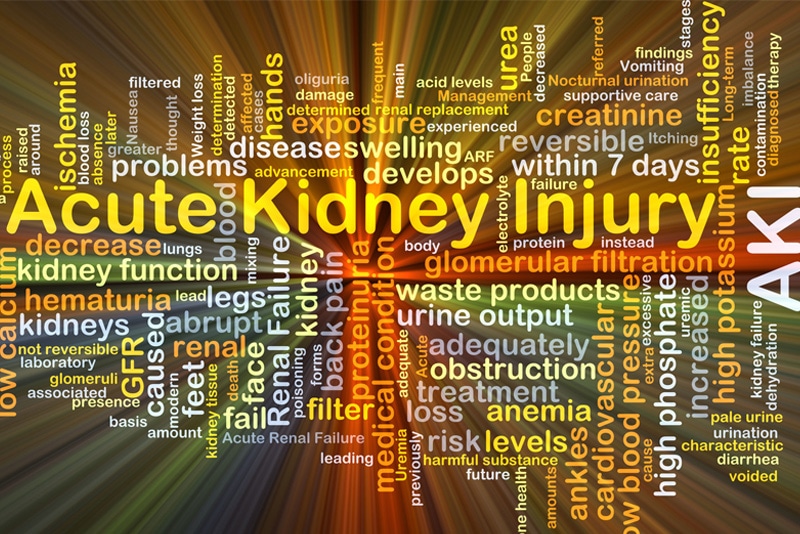Acute kidney injury (AKI) is a serious condition caused when the kidneys stop working suddenly, over a very short period of time (usually 48 hours or less). Several U.S. studies have indicated an increasing incidence of dialysis-treated acute kidney injury since the late 1990s, making AKI a common diagnosis seen by medical billing and coding companies. Also called acute kidney failure or acute renal failure, AKI may be reversible with immediate and proper treatment. Chronic kidney disease refers to lasting damage to the kidneys that can get worse over time and even lead to kidney failure, or end-stage renal disease (ESRD).
Criteria for Validating a Diagnosis of AKI
The three main criteria used to validate a diagnosis of AKI:
RIFLE Classification-Risk, Injury, Failure, Loss and End-stage kidney disease. When using the RIFLE Classification system for staging of severity, AKI represents stage III.
AKIN Classification-Acute Kidney Injury Network This modified version of the RIFLE criteria was established in 2007.
KDIGO Classification-Kidney Disease Improving Global Outcomes. Released in 2012, this classification adds to the RIFLE and AKIN criteria already in use.
ICD-10 Codes for AKI
N17 Acute kidney failure
N17.0 Acute kidney failure with tubular necrosis
N17.1 Acute kidney failure with acute cortical necrosis
N17.2 Acute kidney failure with medullary necrosis
N17.8 Other acute kidney failure
N17.9 Acute kidney failure, unspecified
- N17.0-Acute kidney failure with tubular necrosis. If the AKI has progressed to acute tubular necrosis (ATN), assign code N17.0. The documentation should be checked for terms such as renal tubular necrosis or tubular necrosis which are also used to describe ATN could also described using terms such as.
- N17.1-Acute kidney failure with acute cortical necrosis. Report N17.1 if the AKI has progressed to acute cortical necrosis. cortical necrosis and renal cortical necrosis are other terms to describe acute cortical necrosis.
- N17.2-Acute kidney failure with medullary necrosis N17.2 is reported if the AKI has progressed to with medullary necrosis. acute medullary [papillary] necrosis or renal medullary necrosis are other terms to describe acute medullary necrosis.
- N17.8-Other acute kidney failure. N17.8 should be reported when there is a specificity to the diagnosis of AKI (non-traumatic), but not one of the above. Excludes1: posttraumatic renal failure.
- N17.9-Acute kidney failure, unspecified. This code is used when only AKI/ARF is documented without documentation of any further specificity.
Meet the Clinical Indicators for AKI
When acute kidney injury (AKI) is documented, the clinical indicators for the condition should be met to report the correct ICD-10 code for AKI. The standardized clinical indicators to help diagnose AKI are based on the timing and amount of reduction in kidney function. The standardized clinical indicators for AKI diagnosis as listed by www.hiacode.com are as follows:
- Decreased urine production-less than 0.5 mL per kg per hour for more than 6 hours
- Edema
- Confusion
- Fatigue/lethargy
- Nausea/vomiting/diarrhea
- Abdominal pain
- Metal taste in mouth
- Increased BUN
- Increased serum creatinine level-increased in greater or equal to 0.3 mg per dL or greater than or equal to 1.5 to twice the patient’s baseline
- Increased potassium
- Anemia
- Proteinuria
- Metabolic acidosis
- Seizures
- Coma
- Abnormal GFR
- Chest pain/pressure
However, experts point out that though the presence of these criteria in the documentation can help ensure the appropriateness of reporting a code for AKI, physician verification is necessary to use them to assign a code.
The Uniform Hospital Discharge Data Set (UHDDS) states that, for a diagnosis to qualify for reporting, one of the following five criteria must be met:
- Clinical evaluation
- Therapeutic treatment
- Diagnostic procedures
- Extended length of hospital stay
- Increased nursing care and/or monitoring
In order to assign the ICD-10 code for AKI as a principal diagnosis or comorbidity or as a complication of care, the criteria for official coding guidelines, Uniform Hospital Discharge Data Set (UHDDS) definition, clinical criteria, and physician or other qualified health care professional documentation must be met.
While coders usually code correctly according to coding rules and regulations, payer denials of AKI in patients with CKD are attributed to lack of sufficient clinical support or documentation within the record or misdiagnosis by the physician, according to a 2019 article published by the Association of Clinical Documentation Integrity Specialists (ACDIS).
Tips for Accurate Coding of AKI
- As there are several different codes to report the diagnosis of acute kidney injury and/or acute renal failure.
- Code assignment should not be based on ancillary test results or therapies alone.
- Diagnosis of AKI should be clearly documented and it should be validated by both the physician or other qualified health care professional documentation, and clinical criteria
- If there is contradictory documentation, the concerned healthcare professional should be queried for clarification. If AKI is documented, but the clinical indicators for acute kidney failure are not met, the provider should be queried.
- To be certain that the physician’s diagnosis is clinically validated, coders should know which criteria their facility uses to diagnose AKI.
- The instructional notes within the ICD-10-CM Index as well as Exclude1 and Excludes2 notes should be followed when coding AKI/ARF
- The underlying condition/cause should be also reported if the cause of AKI/ARF has been identified.
Providers should strengthen their documentation to secure appropriate reimbursement and prevent denials. With the many complexities involved, coding AKI is much easier with professional support from an experienced medical coding and billing company. Skilled AAPC certified coders in such companies will query the provider for clarification of the diagnosis and ensure that the code assignment is based on the documentation and clinical criteria.




